A Different Look at DEI in Higher Education





Some institutions have just scratched the surface. Others have dug deep to ingrain DEI in everything they do.
Although DEI creates ongoing benefits in education, obstacles still exist for students, faculty, and institutions.
Do they lack awareness?
Is DEI seen as an extra expense?
Are they short on time and resources?
Regardless of the reason, if institutions shift their focus and look at DEI through a different lens, they’ll see how it improves the entire teaching and learning experience and creates tangible financial benefits.

“Diversity is the mix of individuals. Inclusion is how you make that mix work.”
Jameel Rush, PHR, SHRM-CP, Director, Inclusion Programs at Google Adjunct professor at Villanova University
Acknowledges, understands, & celebrates our differences. “Who all do we have in our classroom?”
Provides the specific resources & access individuals need. “Is there anyone that can’t access our classroom?
Each person feels truly welcomed, included, and heard. “Does each person in our classroom community feel heard and understood?”
DEI is more than a policy in a syllabus or statement on a website.
Whether it’s students and faculty or deans and provosts, embracing DEI takes a genuine commitment from every single person. But to get there, we need to truly understand the challenges students and institutions face.

Even as the benefits of DEI are recognized and adopted, there are challenges that need to be addressed to help create positive changes.
Breaking down these barriers is the only way to ensure that DEI efforts are supported and utilized to create positive change.
Identifying and eliminating blind spots provides an opportunity to implement the best resources and solutions to overcome DEI barriers.
Ultimately, this builds the groundwork for creating accessible DEI initiatives and resources that benefit institutions and students.

Some institutions see DEI efforts as an expense because they take time, resources… and budget.
Institutions have ongoing spend for salaries, campus maintenance and utilities, technology upgrades, research funding, and more.
In the next section, you’ll see how an investment in DEI creates an endless cycle of benefits that pays for itself.

That’s a significant increase, but there’s a catch:
Even with a 27% increase, the DEI budget still accounts for less than .5% of the total budget for these universities.
To put it into perspective, with a budget of $100, after four years, this investment only shifted from 40 cents to 50 cents.
While budget investment isn’t everything, it’s still an important aspect to improve and support overall DEI efforts.
The problem is that many institutions look at DEI as a cost center rather than an investment opportunity that creates returns in all areas.
We’ve summarized these returns into the 5 Rs of DEI:
1. Reputation
2. Recruitment
3. Retention
4. Revenue
5. Resources
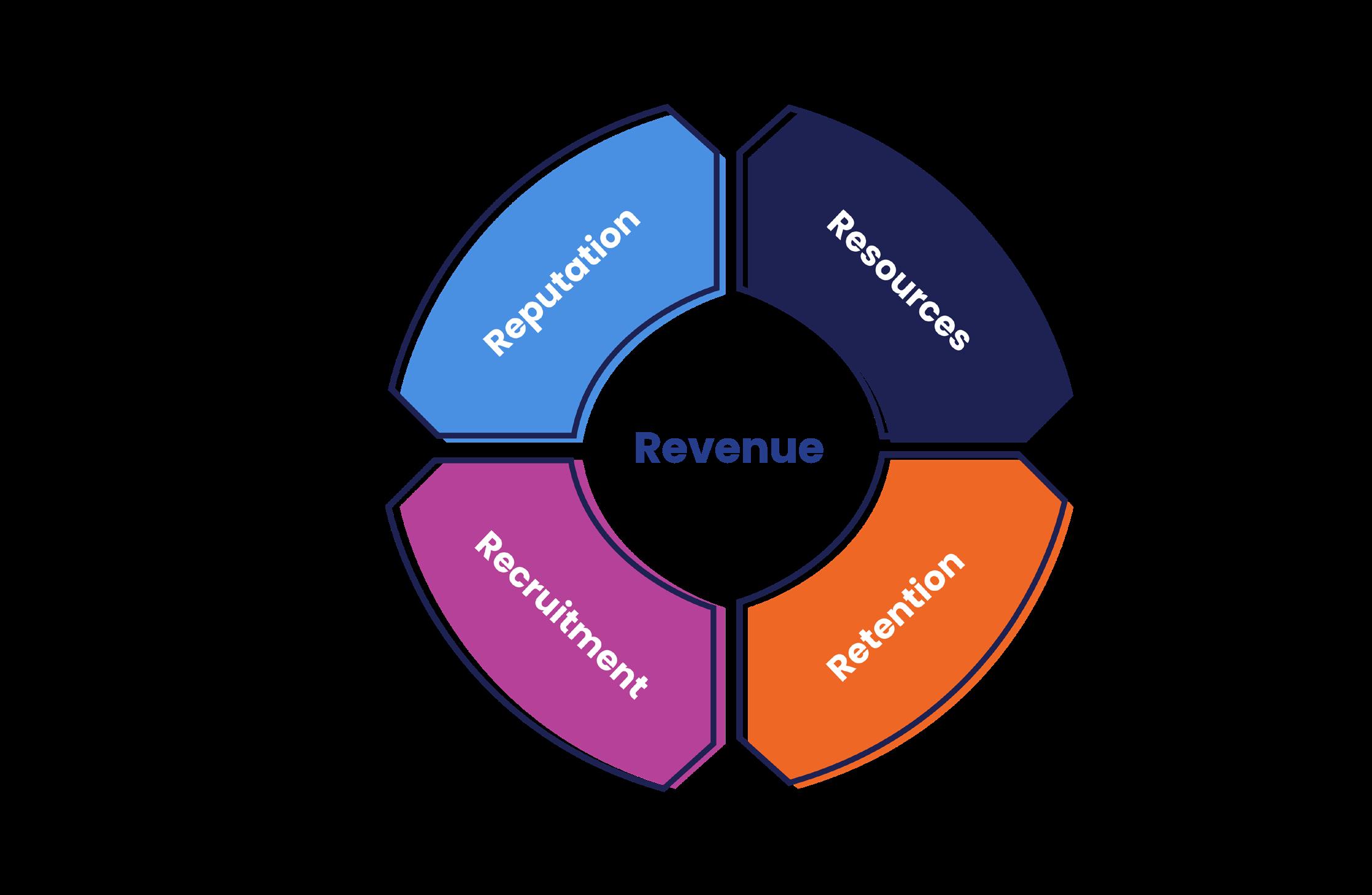
Without a solid reputation, institutions may struggle in many areas, especially with the recruitment and retention of highly desirable students, instructors, and staff.
But reputation extends beyond institutional stakeholders. It also matters to the future employers of students. As an employer, would you rather hire graduates from an institution known for academic rigor or one that’s a step behind?

From offering diverse course content that engages students in new ways to using learning technologies that give students more opportunities to engage and interact (and everything in between), DEI improves the entire learning experience.

A questionable reputation can cause two problems for recruiting:
1. New student enrollment declines
2. Hiring employees becomes a costly, time consuming struggle
In other words, enrollments can decline, and hiring can be a costly struggle.

As a student, would you seek out an institution that lacks progress and resources? Or one that creates access and opportunity for every
student and is known for having a diverse range of top-notch instructors?
And for instructors and staff, would you prefer to work at an institution where you feel left out and struggle to get the resources you need to effectively teach? Probably not.
In fact, one-third of jobseekers won’t apply to organizations that lack diversity2 .
These simple questions demonstrate the trickle-down effect that reputation has on recruitment. Whether you’re a future student or employee, you want equity, access, opportunity, and diversity.
DEI’s impact on recruitment is clear, but there are still challenges to retaining students, instructors, and staff.
DEI helps improve student engagement and success. It challenges students to think and learn in different ways. They feel genuinely included and like they belong. They feel heard and understood. Simply put, DEI creates an engaging environment where students can thrive.
These improvements are supported by research that shows significant improvements in cognitive skills, like critical thinking and problem solving, when students interact with racially and ethnically diverse peers3.
Not only that, another study showed that being surrounded by peers from diverse socioeconomic
backgrounds is proven to improve students’ perceptions of the institution and satisfaction with their educational experience4 .


With more than half of the higher education workforce considering new job opportunities in the next year5, employee retention is crucial for institutions.
What some may not realize is that DEI initiatives improve job satisfaction and engagement, which could be the key to retaining more faculty.
A survey found that as DEI efforts in the workplace increase, job satisfaction increases as well6. In addition, DEI efforts increase work engagement by 35%, and about 20% of employees at organizations with DEI initiatives are likely to stay longer7.

To summarize, institutions need to kickstart DEI initiatives to help retain more students, faculty, and staff.



This one’s pretty straight forward.
DEI initiatives can increase the recruitment and retention of students, faculty, and staff, which means more revenue.

Retaining more of the best employees reduces spending for recruitment and training of new hires.
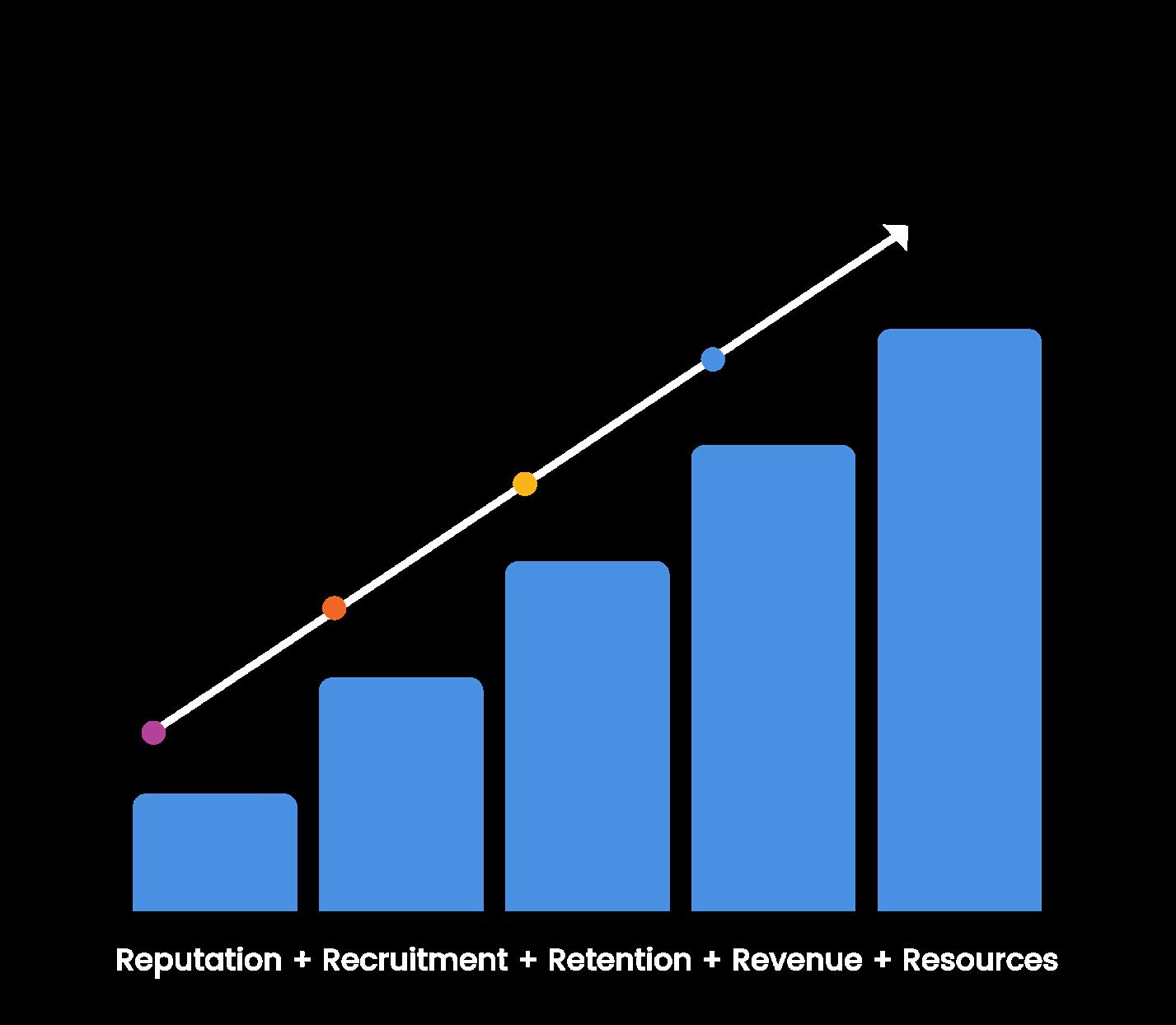
When it’s all said and done, DEI can help increase revenue for institutions.
More revenue means having the ability to invest in more resources for the institution, like new educational technologies and training for faculty and staff. Access to more resources helps institutions improve the educational experience for everyone.
DEI creates interconnected improvements to reputation, recruitment, retention, resources, and revenue – the 5 Rs. It provides valuable, lasting benefits for




faculty and staff, and institutions.
1. https://www.insightintodiversity.com/an-insight-investigation-accounting-for-just-0-5-ofhigher-educations-budgets-even-minimal-diversity-funding-supports-their-bottom-line/
2. Glassdoor’s Diversity and Inclusion Workplace Survey.” Glassdoor, 2020 https://www.glassdoor.com/blog/glassdoors-diversity-and-inclusion-workplace-survey/
3. Bowman, N. A. (2010). College Diversity Experiences and Cognitive Development: A Meta-Analysis. Review of Educational Research, 80(1), 4–33. https://doi.org/10.3102/0034654309352495
4. Park, J. J., Denson, N., & Bowman, N. A. (2013). Does Socioeconomic Diversity Make a Difference? Examining the Effects of Racial and Socioeconomic Diversity on the Campus Climate for Diversity. American Educational Research Journal, 50(3), 466–496. https://doi.org/10.3102/0002831212468290
5. https://www.cupahr.org/blog/more-than-half-of-college-employees-are-likely-to-look-forother-employment-in-near-future-2022-07/
6. https://www.momentive.ai/en/blog/dei-key-to-retaining-employees/
7. https://www.catalyst.org/research/inclusive-leadership-report/

Building DEI efforts can help improve your institution’s reputation, and it’s critical to recruiting students, faculty, and staff of diverse backgrounds. But it can be difficult to measure and analyze the impact of DEI initiatives, leading to inaction, focusing on the wrong efforts, or an inability to provide the most effective DEI resources to those who need them most.
This section will give you insight about what to measure and where to find the data for students, instructors and staff, and from an institutional perspective.
From there, you’ll learn how to identify gaps and understand what causes them, measure success, and take action to improve DEI.
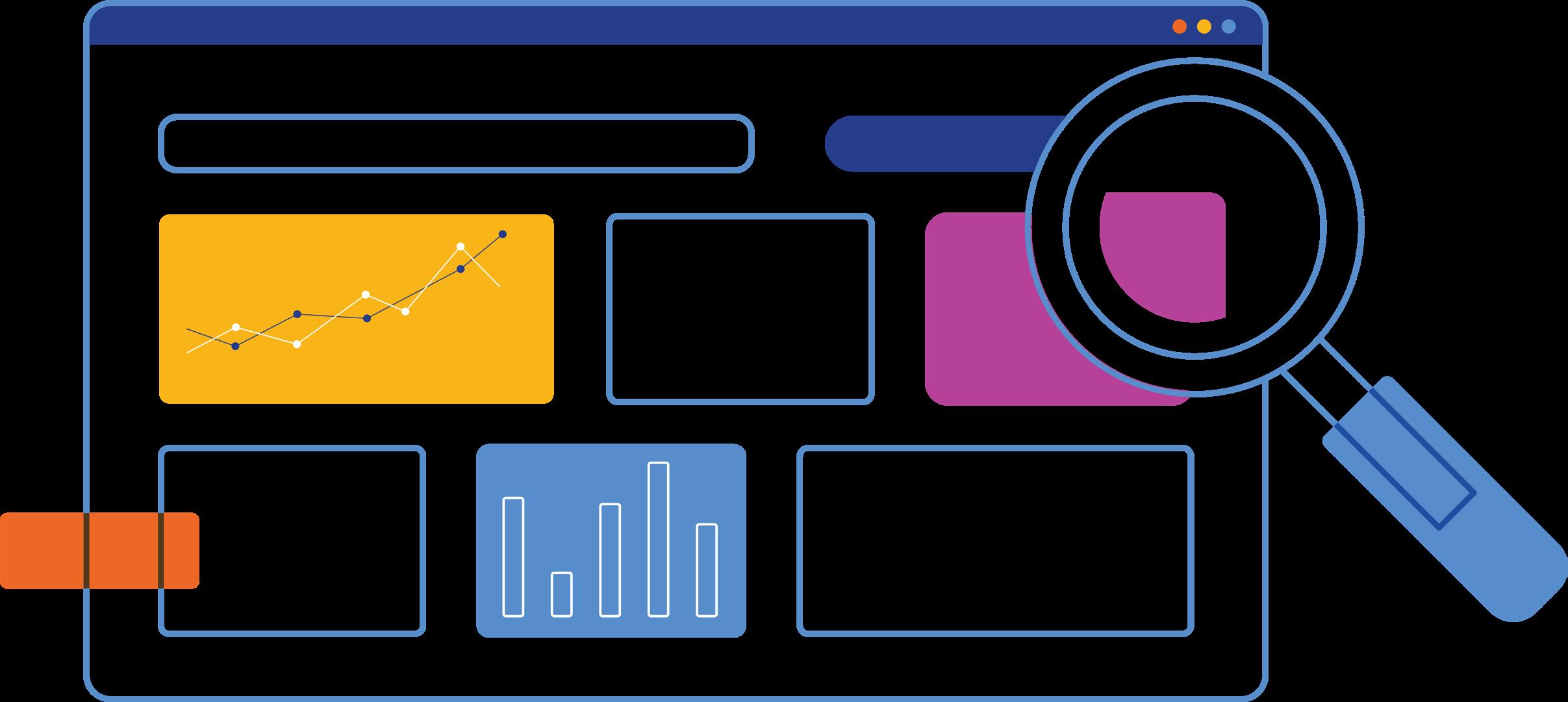
To begin, organizations should undertake a comprehensive audit of the current state of DEI efforts and define future goals.
A great place to start is by compiling all the organizational data on the DEI efforts currently underway.
But DEI-related data can come from a variety of sources. Some data, like student demographics, likely already exist, while other data points will need to be gathered through tools like surveys or even simple conversations.
We’ll summarize the most common types of data to compile for:
• Students
• Faculty & staff
• Institutions
Use anonymous surveys for students & employees
Anonymous surveys can increase response rates & you’re more likely to receive honest feedback.
Demographic data can be collected, but the responses aren’t linked to a specific person.Saleh, A., & Bista, K. (2017). Examining Factors Impacting Online Survey Response Rates in Educational Research. Journal of MultiDisciplinary Evaluation, 13(29).
Use admissions information to gather student demographic data such as gender, race, ethnicity, and age. It’s also important to collect data about student disabilities and conditions, which can impact how online education is delivered and supplied, such as addressing needs for assistive devices and other learning technologies.
Data on academic performance, correlated with demographic data, can shed light on the students or groups that are more or less likely to succeed. This is a good way to identify opportunities to roll out new DEI initiatives that support student success and measure how existing and new DEI efforts impact student success.
Example:
You find that 20% of your total student population and 35% of your online students have a disability or condition that impacts their ability to engage, interact, and learn.
However, after analyzing the performance of these students, you find that online students with a disability or condition achieve lower grades than those who attend classes on campus.
This could be caused for several reasons, like the course level or course curriculum. But it could be caused by accessibility issues in the online courses that negatively impact online students’ ability to access and engage with course content.
Without asking for it, most students don’t share the impact of DEI efforts with institutions. Conduct regular student surveys to understand student experiences, opinions, ideas, and awareness of DEI initiatives in order to collect this rich data. Surveys can help understand why students choose a particular university or why they decide to leave, both of which could include important factors related to DEI.
Compensation data should be readily available within HR and accounting systems. Gathering this information can highlight potential gaps or biases and should be part of this initial audit.
However, it’s important not to jump to conclusions based on compensation alone. When evaluating compensation differences, leaders must take into account any outlying factors tied to individual compensation packages.
Example:
A compensation analysis shows that some female instructors in the business department aren’t compensated as well as male instructors with similar years of employment at the institution. Additionally, after digging in further, you find that Black females in particular are compensated less than White females.
Other factors that can impact compensation include performance, the number of classes each instructor teaches, departmental research grants and donations, and fundraising, among other factors.
Understanding all this information helps paint a picture of whether gaps in compensation are due to potential bias or not. In this scenario, start by looking at individual performance reviews for the department’s female and male instructors with similar years of experience and who teach the same number of classes. Look into the other factors listed above. If all factors are equal except salary, this may point to a bias.
Scenario A: 12% of the female performance review scores were below average, while only 10% of male performance reviews were below average.
In this scenario, the difference between the percentage of females and males who received below average scores is relatively small. While these scores may not be the sole reason behind the compensation gap, they could be a contributing factor.
You can also look at the individuals or teams behind the reviews. Are they judging individuals differently based on biased beliefs that cause lower scores for one segment?
Scenario B: 45% of White females received above average performance reviews, and 37% of Black females received the same.
The percentages in Scenario B are significant, which could be an indicator of potential bias against Black female instructors. But again, dig into this information comprehensively to determine what factors may be contributing to the compensation gap. True performance is acceptable, but inherent biases against capability related to race are not.
Most institutions have faculty and staff demographic data available within the systems used for HR purposes.
Understanding demographic information at every level is important because an institution may have a diverse workforce as a whole but still struggle in key areas, like diversity in positions of leadership. An institution may be diverse in terms of race or ethnicity, but there could also be gaps in the number of male and female employees.
It’s important to understand if an institution’s leadership team is truly diverse. Gather data around employee demographics and positions of leadership to identify any gaps that exist in leadership roles.
This information could be tricky to gather, depending on the level (formal or informal) of past DEI training. Some institutions use the LMS to test knowledge based on information covered during training. In contrast, other institutions may consider watching a video as training.
Regardless of type, gather any available data about DEI training, such as:

• Number and frequency of DEI-specific training sessions
• Number of hours per session and total hours each quarter or year
• Scores and ratings for DEI training exams
• Percentage of employees that participated in or completed DEI training
• Percentage of managers that participated in or completed DEI training
• Percentage of senior leadership that participated in or completed DEI training
Define what roles your institution considers to be “leadership.” Does a leadership role mean director titles and above? VP and above? Defining what roles/titles are considered leadership helps objectively measure leadership diversity.
Like with students, conducting surveys with faculty and staff on a regular basis helps leaders understand opinions, expectations, awareness, and understanding of DEI efforts at the institution. It uncovers information that might not otherwise be available and gives employees a voice in the development of DEI initiatives that meet their needs.
A few ways to segment employees for surveys:

• Department or college within the institution
• Specific roles
• All employees
Aside from the data for students, faculty and staff, leaders should also look to gather institutional information that can be used to improve DEI efforts.
Data from operational and institutional efforts can help teams understand the financial impact of DEI initiatives, the gaps that exist, and the allocated budget.
Gather data about the average spend on DEI initiatives each year.
• What percent of the budget is spent on DEI?
• How much has DEI-related spending increased or decreased year-over-year?
• Where is the spending allocated? For example, employee training, campus events for students, third-party research, and so on.
How do DEI initiatives impact recruitment and retention of students and employees? Have those areas seen improvements? If so, what’s the financial impact?
Example: DEI may improve employee engagement, which can lead to better retention rates. How much does this save in reduced turnover and new employee training? Evaluate and measure every aspect of improvement DEI creates.
Levels of job candidate progression
Look at the number or percent of diverse candidates and how they progress through different levels in the recruitment and hiring process.
• Level 1: Diverse candidates in the total pool of candidates
• Level 2: Diverse candidates receiving interviews
• Level 3: Diverse candidates that receive job offers
• Level 4: Diverse candidates that accept job offers
After gathering this data, determine which levels need to improve and which are in good standing. Set realistic goals to maintain and improve these levels, starting with the lower levels.
The examples below are a brief look at data to gather about the retention of diverse employees and leaders. Are there any areas of employee retention that are weaker than others? If yes, dig into why.

Number/percent of diversity:
• Employees who leave the institution before [number] days.
• Employees that have been at the institution for at least [number] months/years.
• Leaders who leave the institution before [number] days/months.
• Leaders who have been at the institution for at least [number] months/years.
After gathering all the relevant data, identify areas of strength and areas for improvement.
• Do student surveys indicate that all students feel welcomed and included?
• Are there compensation gaps for certain groups of employees?
• Is the student population diverse? Is it diverse in a balanced way?
• Are faculty members requesting more training and resources?
• Is the leadership team diverse?
Once this bigger picture of DEI initiatives emerges, the next step is to set goals that outline where the institution should be and the potential impact of achieving this desired state once the goals are reached. It’s important to be specific and realistic about goals, milestones along the way, and the timeline.
Make course content accessible by the end of the Spring semester
Meet Section 508 compliance standards for at least 75% of all online course content by June 30, 20__.
Hire more women in leadership roles
Increase the number of women in leadership roles (director-level job titles and above) by 30% by August 31, 20__.
Conduct more DEI training sessions for faculty
Conduct one mandatory DEI training session for all faculty members every 90 days during 20__. Four total training sessions for the year.
After identifying what’s working and what needs improvement, focus on the areas of opportunity. How can these areas of opportunity be addressed in order to meet the DEI goals?
For this example, assume that the data indicates two things about online students:
1. 85% feel welcomed and included because of the student orientation
2. 35% believe that online course content doesn’t meet their accessibility needs
Overall, the student orientation is in good standing and can likely be improved with some small additions. However, the real priority is improving the accessibility of online course content. You’ll see in the steps below that efforts for each can benefit the other.
1. Make quick accessibility updates while planning longer-term efforts
LMS administrators can make quick changes to global LMS settings that impact the online course experience for a large number of students, such as:
• Correcting LMS colors to meet contrast ratio compliance standards
• Adjusting keyboard functions to make page navigation more efficient
2. Define longer-term efforts
While quick changes are being implemented, prepare long-term efforts, such as:
• Progressive training sessions that teach faculty how to create accessible course content
• Continually developing comprehensive accessibility resources that faculty can use while creating content in the future
While 85% of students indicated that the orientation process made them feel welcomed and included, there are likely still some ways to improve. Adding questions about accessibility to the surveys can help students see that their wellbeing and needs are important, right from the beginning of their relationship with the institution.
• Gathering information about how to further improve the student orientation
• Better understanding student accessibility needs
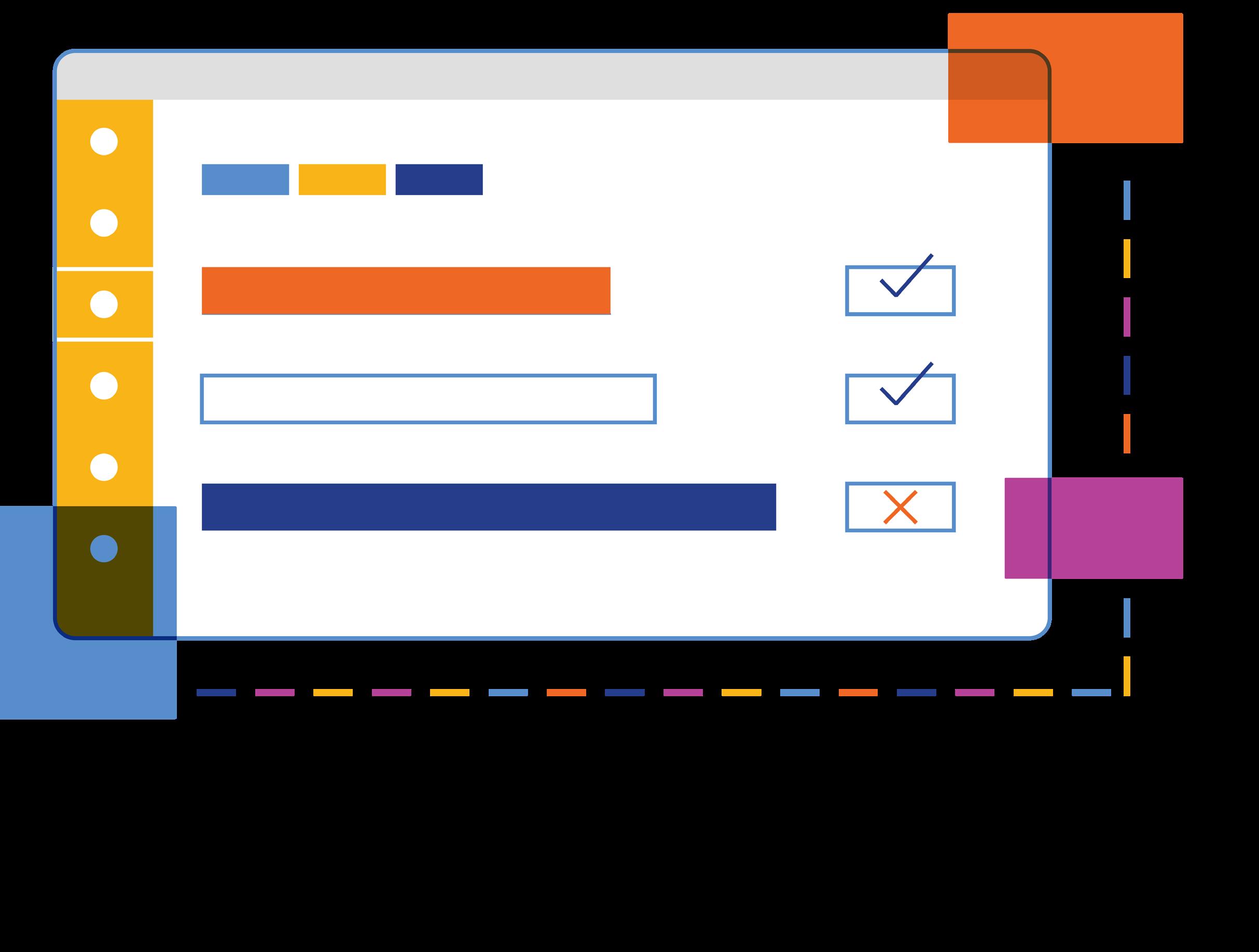
Measurement goes beyond just analyzing the impact of DEI initiatives. Collecting and analyzing the right data provides valuable insight to help refine and improve initiatives that directly impact reputation, recruitment, retention, resources, and revenue – the 5 Rs.
Ultimately, allowing institutions to deliver an exceptional educational experience for students and an elevated teaching experience for instructors.

Instead of asking general questions, ask a series of specific questions to get a better understanding.
Don’t just ask students “Did you like the student orientation?”
Ask questions that give you more details, such as:
1. During the student orientation, did you enjoy connecting with other students and instructors before classes started?
2. What orientation activity did you enjoy the most?
Tip: For this question, you can include choices such as: virtual meet-and-greets, games, instructor office hours, early access to the online course, forum discussions, etc.
3. Was there any information missing that would be helpful?
Tip: If they choose “Yes”, ask them to provide more context about what information they would like to see.
4. Was it easy to find the information you needed?
5. Were you aware of the student orientation information and activities prior to classes starting?
• If yes, how long were you aware before the semester started?
Tip: Give options such as: Less than a day, a few days, one week, two weeks, etc.
6. If not, when did you register before the semester started?
Tip: Give options such as: Less than a day, a few days, one week, two weeks, etc.
7. How did you become aware of the student orientation?
Tip: Give a list of offered options, such as: email, website, LMS announcement, other student, etc.
© Honorlock 2023
Instead of asking, “How do you feel about speaking during department meetings?”
Ask faculty and staff a series of questions, such as:
1. How comfortable are you with speaking up during a department meeting?
2. If you do speak during a department meeting, do you feel that your input is listened to and understood?
3. If you have a question or something to contribute during a meeting, how likely are you to speak up?
4. Do you believe departmental meetings give faculty and staff enough opportunities to contribute?
“The one argument for accessibility that doesn’t get made nearly often enough is how extraordinarily better it makes some people’s lives. How many opportunities do we have to dramatically improve people’s lives just by doing our job a little better?”
- Steve Krug, Author and User Experience Expert
When you’re building an online course, you’ll never say, “Finally, I’ve built the perfect online course that’s 100% accessible.”
Why? Because accessibility in online learning is a continual journey with no destination. Every component of online learning, whether the software used, compliance stands, and even student feedback, constantly changes to meet the needs of students and instructors.
While this journey is a continuous effort with many considerations, it offers plenty of checkpoints and pit stops along the way that provide opportunities to learn and improve through trial and error. Embrace the wins and losses and use them to create a better learning experience for every single student.
How to build accessible online courses
• Real examples and screenshots of what to do vs what not to do
• A summary of POUR principles
Important web accessibility compliance standards to follow
• Summaries of the three main compliance standards
• Financial consequences for noncompliance
• Common assistive technologies and how they work
• Assistive technology vs accessible technology: what’s the difference?
It means using software, tools, technologies, and best practices so that each learner has equitable access and ability to understand, engage, and interact with all elements in the course.
Prevents discrimination against people with disabilities by ADA requiring all electronic information, such as websites and multimedia, to be accessible for people with disabilities.
Creates shared accessibility standards for all web content like text, design, multimedia, and structure.
508
Federal requirement to create and maintain accessible information and communications technology for people who have disabilities. This includes hardware and software, operating systems, multimedia, and more.
? ? ?
Aside from putting the institution’s reputation at risk and creating a bad user experience, not meeting web accessibility compliance standards is a huge financial risk.
By law, universities and colleges that receive federal financial aid are required to meet web accessibility compliance standards or provide reasonable accommodations.
POUR breaks web accessibility down to four guiding principles: perceivable, operable, usable, and robust.
Students can identify content & elements using their senses


Interactive elements of the user interface & navigation are operable
Students can comprehend the content & learn
Content is usable across most devices & assistive technology
Use appropriate contrast ratios to ensure that all text color is easily visible against the background color.
Keep in mind that different standards have different ratios and that font size can impact contrast pass or fail.
The example below shows the fine line between color contrast that’s accessible for all standards compared to others that only pass for larger text.



Use Sans Serif fonts because they’re easier to read compared to Serif fonts. Serif fonts have small lines at the ends of the letter (circled in the example below) that can make it more difficult to read.

Common Serif fonts:
• Times New Roman
• Garamond
• Georgia
Common Sans serif fonts:
• Arial
• Helvetica
• Calibri
Some fonts are inherently larger than others even though they may technically have the same size font point.
This sentence uses an 18pt font. This sentence uses an 18pt font.
Even though both sentences above use Sans Serif fonts (the first is Arial, the second is Calibri) that are the same font point, they’re significantly different sizes overall.
Use actual headings, not just bolded font
Headings (H1, H2, H3, etc.) should clearly define the intent of the elements of your content and help screen readers understand the structure and hierarchy.
Headings should be in order
Do: H1, H2, H3
Do not: H1, H3, H2
Numbered (ordered) or bulleted (unordered) lists help assistive technologies, like screen readers, understand the items on the list. Hyphens don’t help assistive technology understand the items on the list.
Do: Topic
• Subtopic
• Subtopic
• Subtopic
Do not: Topic - Subtopic - Subtopic - Subtopic
Using a consistent course structure helps students navigate and better understand course content because it’s predictable and easier to follow.
The “Do” layout example makes the course content easier to follow by clearly breaking out Readings and Assignments, providing further context of what the course elements are (e.g., PDF or website), and what action is needed for each assignment (e.g., submit Excel Document).
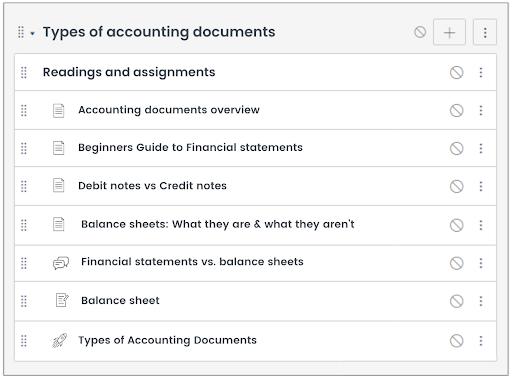

Do: Do not:
Descriptive link text is important for people with visual impairment because it gives context and purpose. If the person is using a screen reader and the entire page says, “Click here” and “Learn more” it’s difficult to find what they need.
Hyperlink text tips:
• Changing the color of the hyperlink text isn’t enough
• Hyperlink text should provide the context and purpose of the link
• Do: Read Article 1 for Week 2
• Do not: Read more
All video, audio, images, and any other multimedia content should have text alternatives (captioning & subtitles, transcripts, and descriptions) to help students perceive and understand the content.

These seem similar, but it’s important to understand the differences.
Subtitles = what’s said
Captions = what’s said + non-speech elements (a dog barking)
Captioning tip: only provide enough detail to help students understand what’s happening. Too many details, like in this example, can be distracting without providing any beneficial information.
Content that flashes or blinks can cause seizures. WCAG recommends that if content must flash or blink, students should be able to disable it and there shouldn’t be more than three flashes/blinks in one second.

Audio descriptions & transcripts
Audio descriptions and transcripts are meant to provide important visual aspects of the video for those who are unable to see.
Image text descriptions
Image text descriptions provide the context and purpose of the image. This text is used in place of the image and improves the accessibility of the page for users with visual impairments.
Tips for writing image text descriptions:
• Accurately describe the image in 125 words or less (avoid using one word only)


• Don’t use “image of” or “picture of” or similar wording
• Read it out loud to ensure that it makes sense
Tip!
Person hiking
Image of a person hiking

Man hiking up a mountain using a trekking pole and wearing a backpack.
Download ebook
Image of budgeting ebook

Downloadable ebook about budgeting tips for students written by Finance Pros.

Just like video captions, audio descriptions should be concise so that the listener isn’t overwhelmed with too much information.
Students may need a variety of accommodations, such as:
• Extended time limits and due dates
• Bathroom breaks
• Alternative ways to answer questions
• Allowing other people in the room
• Permitting the use of assistive technologies, like screen readers and talk-to-text dictation software
Find different types of content to use in your course from a variety of sources. This helps students understand different perspectives, ideas, and beliefs about a subject.
Use different types of content, like research studies, news articles, magazines, case studies, books, videos, and more.
Find content from at least two sources from different backgrounds, such as those from other genders, races, ethnicities, and religions.
Use anonymous surveys throughout the course to gather student feedback and information about their experience, accessibility needs, what they enjoyed, and what can be improved.
Create a central location, whether it’s in the syllabus or the course homepage, that gives students a comprehensive list of help resources, such as:

• Campus writing center and tutoring services information
• Links to the institution’s online library and open educational resources (OER)
• Technical support access
• Student study groups
• Contact information for accessibility-related departments and personnel
You should also provide specific hardware and software used in the course, such as the LMS and how to use it, how online proctoring software works, and minimum system requirements such as the appropriate devices, operating system, browser, and internet speed.
Assistive technologies are software and hardware that helps students understand, engage, and interact with online course content.

Common assistive technologies include:
• Screenreaders
• Assistive keyboards
• Dictation software
• Braille displays
• Screen magnifiers
Assistive technology vs accessible technology
The terms are used interchangeably, but they’re different.
Assistive technology
Designed to help students perform specific tasks.
• e.g., dictation software turns spoken words into text
Accessible technology
Designed to meet a broad range of needs.
• e.g., the LMS provides customizable colors and fonts and online proctoring software that integrates with assistive technology

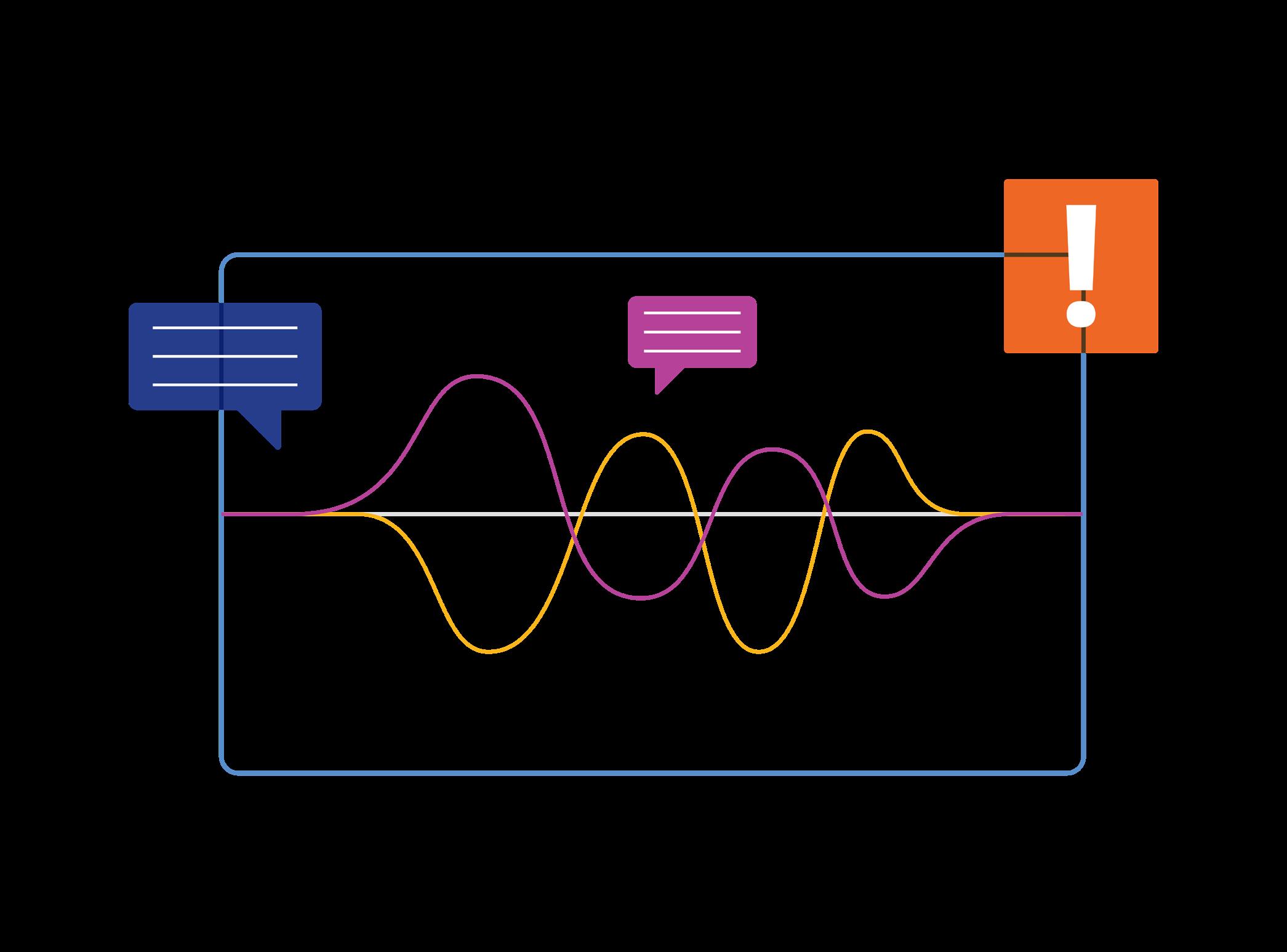
Educators and institutions ultimately aim to improve the teaching and learning experience, which includes creating a fair and equitable testing environment.
We’ll show you how technology, such as the LMS, assistive devices, and online proctoring, can help students in three testing scenarios:
Scenario 1: A student with mobility impairments takes an online exam requiring physical activity.
Scenario 2: A student wears religious attire during a proctored exam.
Scenario 3:
Scenario 1: A student with mobility impairments, which impact arm movement and speech, takes an exam that requires a virtual presentation with spoken portions and a hands-on demonstration of a device.
LMS settings and online proctoring can provide the student with alternative options to complete the presentation.
Instructors can provide specific accommodations, such as:
The LMS, online proctoring, and third-party test platforms should be accessible and able to integrate with assistive technologies.
This way, the student can use various assistive technologies, such as an adaptive keyboard, a screen reader, voice dictation software, and eye-tracking software. If online proctoring is used, some platforms allow instructors to provide the live proctor with instructions to allow assistive technology.
Assistive technologies are great at helping students complete activities during an exam, but sometimes they take extra time to operate. With that in mind, instructors can use LMS settings to extend time limits for specific students.
Depending on the physical disability, some students may need another person in the room to help them with certain activities, like holding a device.
With online proctoring, the instructor simply provides the live proctor with instructions allowing another person in the room to help the student without being flagged. Honorlock’s proctoring software provides the instructor with a video recording of the presentation, along with audio and a transcript of what the student said.
Scenario 2: A student is wearing religious attire while taking a proctored online exam.
Some students may wear religious attire, such as face coverings, during the proctored exam.
Unfortunately, some proctoring solutions can’t accommodate this and may flag the student for covering their face. This may increase student test anxiety, and it can make the review process longer for instructors.
But instructors using Honorlock’s blended proctoring solution, can provide the proctor with instructions allowing the student to wear religious attire during the exam.
Scenario 3: A student taking a proctored exam in a loud environment.
Many students live in small dorms and busy households, which means they don’t have the option to take a proctored exam in a quiet environment.
If the online proctoring software uses sound detection, which is different from voice detection, the student may be flagged for noises like a dog barking or a doorbell ringing. This can increase test anxiety because students are concerned with being flagged for cheating.
Here’s how a blended proctoring solution like Honorlock can help students in these scenarios:

Students can take the exam at any time
Honorlock’s blended proctoring solution is available 24/7/365, which allows students to take exams and get support during times when their roommates or family members aren’t home.
Instructors can decide which features to enable/disable during the exam. So, if the student informs the instructor of their living situation, the instructor can disable voice detection and/or give instructions to the proctor to not interrupt the student if other people are in the room or for unimportant voices.
This way, the student won’t have to worry about being flagged for family members speaking to each other or if their roommate walks into the dorm.
Honorlock combines AI proctoring software with live proctors. Our blended solution helps create an equitable testing environment that supports students while still protecting academic integrity.
While other proctoring services simply try to catch cheating, Honorlock aims to bring integrity, humanity, confidence, and positive outcomes to students, faculty, and institutions.
Naz Erenguc, Director of Admissions at the Warrington College of Business, University of Florida

“Honorlock helps us get to the core of our mission here at Warrington: being able to offer an MBA to just about anybody. Having a proctoring service focused on diversity, equity, and inclusion made choosing Honorlock an easy fit for us.”
